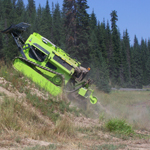A Safer Solution to Fighting Wildfires
Media Contact:
Jennifer Martin, (202) 720-8188
By Stacy Kish, CSREES Staff
August 22, 2008

The SCT2 taking on an incline.
Credit:
Cindy McCool
Sacrificing their own safety for the safety and protection of others has long been a duty of a firefighter. Now, new technologies make it possible to reduce that risk for firefighters while battling wildfires in the United States.
TNC Industries Inc., using Phase II funding from USDA's Cooperative State Research, Education, and Extension Service Small Business Innovation Research (SBIR) program, modified and improved a wireless remote control tractor for use in forest fire operations.
The Small Crawler Tractor 2 (SCT2), designed, fabricated and assembled by TNC-2 Industries in Weippe, Idaho, provides maximum safety to firefighters by building a fire line in front of wildfires. The relatively small, tractor can be controlled remotely at a maximum distance of 150 yards. It can cut a 50-inch wide and 10-inch deep swath in brush, and the powerful hydrostatic motor can till brush, rocks, and grass with ease. It also contains a 100-gallon suppression water tank with a high-pressure pump that can serve as a mobile pumping station.
The SCT2 was successfully deployed at several wildfires in the summer of 2007 with input and support from the U.S. Forest Service and other partners. The U.S. Forest Service, National Interagency Fire Center deployed the SCT2 at the Jocko Lakes fire on the Lolo National Forest near Seely Lake, Mont., August 14, 2007. After three successful days, the tractor was reassigned to the Shower Bath fire on the Salmon Challis National Forest in Idaho.
The SCT2 was responsible for building a fire line around a farm in the affected area in Idaho. The region consisted mostly of sage brush and rocky terrain. Working for 5 days at this site, the tractor's blade overcame the rocks to remove the roots of the sagebrush.
The SCT2 is also effective in non-fire tasks. The tractor cut a fire line around the TNC-2 facility in grass that was more than four feet tall, winched out a truck that was stuck in the canyon, and tilled gardens for several vendors who raise vegetables for the local farmers markets. The SCT2 has also leveled ground and backfilled for a construction site.
TNC-2 Industries is working to secure private funds for phase-3 commercialization of the SCT2. The company's goal is to have wide-scale implementation of this new technology as an additional resource in fire management strategies throughout the United States.
The CSREES SBIR program awards competitive grants to qualified small businesses to support high quality, advanced concepts research related to important scientific problems and opportunities in agriculture that could lead to significant public benefit if successful.
CSREES funded this research project through the SBIR program. Through federal funding and leadership for research, education and extension programs, CSREES focuses on investing in science and solving critical issues impacting people's daily lives and the nation's future. For more information, visit www.csrees.usda.gov.
###
Last Updated: 08/22/2008





